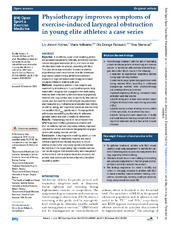| dc.contributor.author | Kolnes, Liv-Jorunn | en_US |
| dc.contributor.author | Vollsæter, Maria | en_US |
| dc.contributor.author | Røksund, Ola Drange | en_US |
| dc.contributor.author | Stensrud, Trine | en_US |
| dc.date.accessioned | 2019-08-15T07:42:30Z | |
| dc.date.available | 2019-08-15T07:42:30Z | |
| dc.date.issued | 2019 | |
| dc.Published | Kolnes L.-J., Vollsæter M, Røksund OD, Stensrud T. Physiotherapy improves symptoms of exercise-induced laryngeal obstruction in young elite athletes: A case series. BMJ Open sport & exercise medicine. 2019;5:e000487 | eng |
| dc.identifier.issn | 2055-7647 | |
| dc.identifier.uri | https://hdl.handle.net/1956/20673 | |
| dc.description.abstract | Objective: A constricted, upper chest breathing pattern and postural dealignments habitually accompany exercise-induced laryngeal obstruction (EILO), but there are few effective treatments for athletes presenting with EILO. This case series was conducted to examine whether physiotherapy based on principles from the Norwegian psychomotor physiotherapy (NPMP) combined with elements of cognitive behavioural therapy can reduce laryngeal distress in athletes with EILO. Methods: Respiratory distress in four subjects was examined by interview prior to a physiotherapeutic body examination. Inappropriate laryngeal movements during exercise were measured by the continuous laryngoscopy exercise test, lung function was measured by flow-volume curves, and non-specific bronchial hyper-responsiveness was measured by a methacholine provocation test. History of asthma, allergy and respiratory symptoms was recorded in a modified AQUA2008 questionnaire. Parasympathetic activity was assessed by pupillometry. All data were gathered before and after 5 months of intervention. Results: Physiotherapy based on the principles from NPMP improved breathing problems in athletes with EILO. All athletes had less respiratory distress, improved lung function at rest and reduced inappropriate laryngeal movements during maximal exercise. Conclusion: A diaphragmatic breathing pattern, a more balanced tension in respiratory muscles, and sound cervical alignment and stability may help to reduce adverse stress on the respiratory system and optimise the function of the larynx during high-intensity exercise. Our results suggest that understanding and management of EILO need to extend beyond structures located in the anterior neck and include factors influencing the whole respiratory system. | en_US |
| dc.language.iso | eng | eng |
| dc.publisher | BMJ Publishing Group | eng |
| dc.rights | Attribution-Non Commercial CC BY-NC | eng |
| dc.rights.uri | http://creativecommons.org/licenses/by-nc/4.0/ | eng |
| dc.title | Physiotherapy improves symptoms of exercise-induced laryngeal obstruction in young elite athletes: A case series | en_US |
| dc.type | Peer reviewed | |
| dc.type | Journal article | |
| dc.date.updated | 2019-05-24T08:19:04Z | |
| dc.description.version | publishedVersion | en_US |
| dc.rights.holder | Copyright 2019 The Authors | |
| dc.identifier.doi | https://doi.org/10.1136/bmjsem-2018-000487 | |
| dc.identifier.cristin | 1666956 | |
| dc.source.journal | BMJ Open sport & exercise medicine | |

